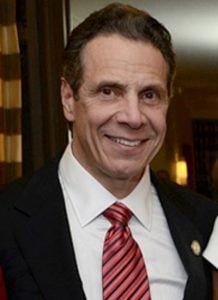Behind the Facade at the New York State Athletic Commission: Part Two

On December 29, 2017, a New York Times investigative report explored New York governor Andrew Cuomo’s oversight of the Metropolitan Transportation Authority. In one instance, 900 workers were paid to perform 700 jobs as part of a 3.5-mile subway tunnel construction project. “Officials,” the report read, “could not find any reason for the other 200 people to be there.” The resulting project cost nearly $3.5 billion for each new mile of track, multiples more than similar projects in other cities throughout the United States.
The NYSAC doesn’t have a budget like its counterparts in states like California and Nevada… much of its cost to taxpayers is hidden from public scrutiny.
There was a trade-off, of course. As reported by the Times, “Trade unions, which have closely aligned themselves with Cuomo and other politicians, have secured deals requiring underground construction work to be staffed by as many as four times more laborers than elsewhere in the world. Construction companies, which have given millions of dollars in campaign donations in recent years, have increased their projected costs by up to 50 percent when bidding for work from the M.T.A.”
A subsequent New York Times editorial entitled “A Gold-Plated Ramshackle Subway” declared, “Billions of dollars that could have gone to maintaining and improving the subways have been wasted.”
It’s difficult to fully comprehend the corruption and waste in massive government undertakings like public transportation because of the size of the bureaucracy involved. The New York State Athletic Commission is more easily studied. But even here, details are hard to come by.
The NYSAC doesn’t have a budget like its counterparts in states like California and Nevada. Its economic mysteries are folded into the New York State Department of State budget. Thus, much of its cost to taxpayers is hidden from public scrutiny.
To date, both the NYSAC and Department of State have refused requests to provide information stating the total annual cost of operating the commission and a breakdown of these costs (e.g. salaries, travel expenses, office space, etc.).

Governor Cuomo (andrewcuomo.com)
Meanwhile, Governor Cuomo has touted combat sports as a money-maker for the State of New York. On December 20, 2018, the governor’s press office issued a media release praising “the success of New York State’s mixed martial arts, boxing, and wrestling industries,” and declaring that, since September 2016 when MMA became legal in New York, “overall revenue from combat sports” has jumped from $15,950,000 to $48,500,000 annually.
But let’s look more closely at the numbers. The bulk of this revenue goes to out-of-state corporations and fighters who live out of state. There has been a modest increase in economic activity surrounding big fights (e.g. at hotels and restaurants). But this increase has been offset in part by the near-extinction of small boxing cards due to an insurance requirement that has killed boxing upstate and decimated small club shows in New York City.
Moreover, using the Governor’s own data, only $3,788,082 per year in state taxes has been paid on the revenue that he cites. That’s because the state has agreed to cap the TV revenue taxes and ticket revenue taxes that promoters pay at $50,000 plus $50,000 per event.
Are combat sports a money-maker for the State of New York? In 2017, the state agreed to pay $22 million to Magomed Adbusalamov and his family to settle claims alleging substandard medical protocols and improper conduct by New York State Athletic Commission employees after Abdusalamov suffered permanent brain damage in a 2013 boxing match at Madison Square Garden.
Want more? The Cuomo press release states, “An April 2017 UFC event in Buffalo generated $3 million in salaries and wages for 72 jobs.”
Think about that for a minute. Do the math. It comes to $41,667 per job for one night’s work. These numbers might average out if the main event fighters’ purses are included, but that’s hardly an economic boom for the State of New York.
Also, one has to consider the cost of operating the New York State Athletic Commission. Government agencies don’t have to be money-makers. They’re providing a service. But let’s be honest about what the numbers are.
The New York State Athletic Commission burns taxpayer dollars by over-staffing fights at taxpayer expense.
It’s an open secret that fighter’s purses are sometimes under-reported to the NYSAC, which enables these fighters and others to escape the full state and city tax payments that should be made.
Similarly, it’s well known that at least one boxing impresario arranges to sell tickets for cash on the street outside the arena on fight night and then facilitates the filing of false reports listing the tickets as comps to avoid taxes.
The New York State Athletic Commission burns taxpayer dollars by over-staffing fights at taxpayer expense. The Pennsylvania State Athletic Commission has 25 to 30 people on site for its biggest events. For the biggest fight cards in Nevada, the NYSAC has up to 45 people on site. By contrast, the New York State Athletic Commission regularly assigns more than sixty people to fights at Madison Square Garden and Barclays Center.
Are all of these employees (most of whom are paid on a per diem basis) necessary? Let’s look at the numbers.
Approximately forty NYSAC personnel were assigned to the UFC event in Buffalo that Governor Cuomo referenced in his December 20, 2018, press release. If more than sixty NYSAC employees are necessary to properly regulate a ten-fight card in New York City, shouldn’t the same number be necessary to properly regulate a 13-fight card upstate? Or are assignments made (and taxpayer dollars unnecessarily spent on transportation, hotel, meals, and salary) so NYSAC personnel can travel from upstate New York to New York City and have a good time?

Ronda Rousey at a WWE card at Madison Square Garden on July 7, 2018. Photo / Thomas Hauser
Another example of waste is the amount of money that the New York State Athletic Commission spends to regulate professional wrestling in New York. Section 213 of the rules promulgated by the NYSAC in 2016 requires that promoters of professional wrestling matches be licensed by the state. The NYSAC assigns at least one official (an inspector or deputy commissioner) to each show. Their job is to ensure that a licensed physician and ambulance are on site. The cost to the state is the per diem salary of the inspector or deputy commissioner and, sometimes, travel expenses.
Isn’t it time that the New York State Athletic Commission stopped wasting taxpayer dollars by “regulating” professional wrestling? If The Great White Hope returned to Broadway, would the NYSAC regulate it? Presumably not. Why not? Because like professional wrestling, a Broadway theatrical production is not a real athletic competition. It’s scripted entertainment.
“But,” Governor Cuomo might say, “WWE combatants can get hurt.”
That’s right. They can. And a Cirque du Soleil performer was killed several years ago when her harness separated from a safety wire and she plunged 94 feet to the stage below. An actor in a Broadway production of Spiderman suffered serious injuries when a line holding him snapped and he fell into the orchestra pit. There are federal, state, and city agencies that deal with these issues. The NYSAC shouldn’t be one of them.
Why did New York State taxpayers pay to regulate 272 wresting events in New York last year?
Too many people at the New York State Department of State and New York State Athletic Commission don’t understand that specialized knowledge is required to regulate combat sports. They have no background in combat sports, don’t understand combat sports, and have little or no respect for what fighters go through. As one deputy commission said recently, “What they know about boxing and MMA would fit in a thimble with room to spare for a finger. All they know about combat sports is that people hit each other.”
The NYSAC is out of touch with the combat sports community. Many people at the commission don’t have a clue as to how much there is that they don’t know. No one is on the ground, following the day-to-day minutiae. Matt Delaglio (the NYSAC director of boxing) comes the closest.
No one from the commission attends pre-fight press conferences or other fight-related events other than weigh-ins and the fights themselves. Often, the commission fails to address a specific issue or problem because its employees don’t even know that the issue or problem exists.
In theory, the New York State Athletic Commission is overseen by five commissioners. But that’s more fiction than fact.
Traditionally, the NYSAC had three commissioners. In 2016, the New York State legislature increased that number from three to five. The commissioners then were Edwin Torres, John Signorile, and Ndidi Massay. Two years passed before the new seats were filled.
On June 30, 2017, Michelle Nicoli-Rosales (Andrew Cuomo’s deputy director of communications for economic development) confirmed that the governor had nominated Dr. James Vosswinkel, Dr. Philip Stieg, and Donald Patterson as new NYSAC commissioners subject to approval by the New York State Senate. Massay’s term was scheduled to run until January 2019. It was unclear whether Torres or Signorile (both of whom were serving on holdover terms) would be replaced. One year later, on June 19, 2018, the state senate voted to approve the appointments of Vosswinkel, Stieg, and Patterson. Signorile was axed.
If Andrew Cuomo truly cared about the mission of the New York State Athletic Commission, he would have used his influence and the power of his office to ensure that five able commissioners with an understanding of combat sports were put in place in a timely manner. Two years is not timely. Moreover, except for Patterson (who has been involved with amateur boxing in Buffalo), it appears as though none of the five current commissioners has had any experience with combat sports.
Torres served as a New York State Supreme Court judge in the Bronx for many years. A biographical sketch on the NYSAC website states, “He is a lifelong boxing enthusiast and was chosen for his legal acumen and his ability to apply his judicial skills in disputed matters that come before the Commission.” But Torres is now 88 years old and no longer has this ability.
Massay is an attorney. The NYSAC website states that she is Executive Director of RISE (Ross Initiative in Sports for Equality). But a review of the RISE website suggests that she no longer has that role.
Steig is a neurosurgeon who currently serves as chairman of the Weill Cornell Brain and Spine Center.

Dr. James Vosswinkel
(stonybrookmedicine.edu)
Vosswinkel is medical director of the Stony Brook University Trauma Center and Surgical Intensive Care Unit. Of the five commissioners, he has been the most engaged in the work of the commission and is the commissioner who has made the most significant commitment in terms of time and effort to the job.
Because of a quirk in state law, Stieg, Massay, and Torres are now serving on a holdover basis and can be dismissed from their positions at any time. Indeed, Torres has been serving on a holdover basis since January 1, 2014. Vosswinkel and Patterson are serving terms that expire on January 1, 2021.
Except for Vosswinkel, the commissioners don’t regularly attend fight cards in New York. When they do, they tend to arrive well after the fights have started. There are occasions when no NYSAC commissioner is on site. They’re more often seen at high-profile events such as Canelo Alvarez vs. Rocky Fielding at Madison Square Garden on December 15, 2018 (when four of the five commissioners were present). Most likely, a majority if not all of the commissioners will attend Anthony Joshua vs. Jarrell Miller at Madison Square Garden on June 1. That night, The Garden will be the place to be.
The commissioners have been inclined to forgo attendance at staff training seminars. On June 30, 2018, the NYSAC held a mandatory staff symposium for doctors, deputy commissioners, and inspectors that was devoted largely to medical issues. None of the five commissioners attended.
In the aftermath of the Magomed Abdusalamov tragedy, the Office of the New York State Inspector General conducted an extensive investigation of the New York State Athletic Commission. In July 2016, it issued a blistering report that, among other things, declared that investigators had “found a lack of appropriate engagement and oversight by Athletic Commission commissioners.”
With the exception of Dr. Vosswinkel, this lack of appropriate engagement and oversight appears to be continuing, as evidenced by a review of recent NYSAC meetings.
Article 7 of the New York State Public Officers Law, otherwise known as the “Open Meetings Law,” requires that meetings of public bodies be open to the general public. Section 100 of this law states, “It is essential to the maintenance of a democratic society that the public business be performed in an open and public manner and that the citizens of this state be fully aware of and able to observe the performance of public officials and attend and listen to the deliberations and decisions that go into the making of public policy.” Certain issues, such as “matters which will imperil the public safety if disclosed,” may be discussed in a closed “executive session.”
On September 26, 2018, the New York State Athletic Commission met for the first time in 357 days. The five commissioners – Edwin Torres, Ndidi Massay, Donald Patterson, Philip Stieg, and James Vosswinkel – were all present. So were executive director Kim Sumbler, director of boxing Matt Delaglio, chief medical officer Nitin Sethi, and commission counsel Theresa D’Andrea. Sumbler began the session with a series of laudatory remarks about those present. The only substantive action the commissioners took was to approve nine new models of boxing gloves based on Delaglio’s recommendation. The entire proceeding lasted thirty minutes.
The next commission meeting took place on December 10, 2018. This time, three of the five commissioners – Vosswinkel, Torres, and Patterson (by telephone) – were present. Sumbler, Delaglio, and D’Andrea were also there. The meeting lasted for seven minutes. The only substantive business conducted was the approval of a new brand of boxing gloves for use in New York.
The following, and most recent, NYSAC meeting occurred on February 28, 2019. Four commissioners – Vosswinkel, Stieg, Massay, and Patterson (via Facetime) – were present, as were Sumbler, Delaglio, Sethi, and D’Andrea. Sumbler reported that the NYSAC had overseen 28 boxing events in 2018, nine major MMA events, 72 smaller MMA competitions, and 272 wrestling events. The commissioners then approved two new boxing gloves and one new MMA glove for use in New York. The meeting lasted eight minutes.
There was no discussion or acknowledgement at any of these meetings of the many important issues facing the New York State Athletic Commission.
Leadership starts at the top. This isn’t a good start.
Read Part Three of “Behind the Facade at the New York State Athletic Commission”
Thomas Hauser can be reached by email at [email protected]. His most recent book – Protect Yourself at All Times – was published by the University of Arkansas Press. In 2004, the Boxing Writers Association of America honored Hauser with the Nat Fleischer Award for career excellence in boxing journalism.














